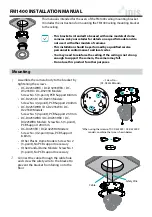
User's Guide ADI-8 DD © RME
25
11. Technical Background
11.1 DS - Double Speed
When activating the
Double Speed
mode the ADI-8 DD operates at double sample rate. The
internal clock 44.1 kHz turns to 88.2 kHz, 48 kHz to 96 kHz. The internal resolution is still 24
bit.
Sample rates above 48 kHz were not always taken for granted, and are still not widely used
because of the CD format (44.1 kHz) dominating everything. Before 1998 there were no re-
ceiver/transmitter circuits available that could receive or transmit more than 48 kHz. Therefore
a work-around was used: instead of two channels, one AES line only carries one channel, of
which the odd and even samples are being distributed to the former left and right channels. By
this, you get the double amount of data, i. e. also double sample rate. Of course in order to
transmit a stereo signal two AES/EBU ports are necessary then.
This transmission mode is being called
Double Wire
in the professional studio world, and is also
known as
S/MUX
in connection with the ADAT format. The DTRS recorder DA-98HR by Tas-
cam also uses this technique, which is called
Dual Line
here.
Not before February 1998, Crystal shipped the first 'single wire' receiver/transmitters that could
also work with double sample rate. It was then possible to transmit two channels of 96 kHz data
via one AES/EBU port.
But
Double Wire
is still far from being dead. On one hand, there are still many devices which
can't handle more than 48 kHz, e. g. digital tape recorders. But also other common interfaces
like ADAT or TDIF are still using this technique.
Because the ADAT interface does not allow for sampling frequencies above 48 kHz (a limita-
tion of the interface hardware), the ADI-8 DD automatically uses the described
Sample Split
method in DS mode. One channel's data is distributed to two channels according to the follow-
ing table:
Original
1
2
3
4
5
6
7
8
DS Signal
Port
1/2
MAIN
3/4
MAIN
5/6
MAIN
7/8
MAIN
1/2
AUX
3/4
AUX
5/6
AUX
7/8
AUX
As the transmission of double rate signals is done at standard sample rate (Single Speed) the
word clock output still delivers 44.1 kHz or 48 kHz.
The wordclock output as well as all ADAT and TDIF ports always operates in Single Speed
mode only. At 96 kHz, the word clock output will therefore be a 48 kHz signal.
The TDIF interface of the ADI-8 DD also supports the 'Double Wire' technique. This allows a
recording with up to 96 kHz at halfed track numbers with every (!) DTRS device.
Note: The ideal combination is an ADI-8 DD together with the digital I/O card
RME Hammerfall
Light
(DIGI9636), which has Sample Split implemented in hardware. This combination offers 4
AES/EBU I/Os, with 2 channels 24 bit/96 kHz each, using PC or Mac.







































